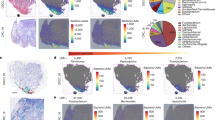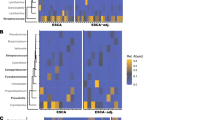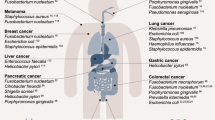Abstract
Single-cell RNA sequencing (scRNAseq) technologies have been beneficial in revealing and describing cellular heterogeneity within mammalian tissues, including solid tumors. However, many of these techniques apply poly(A) selection of RNA, and thus have primarily focused on determining the gene signatures of eukaryotic cellular components of the tumor microenvironment. Microbiome analysis has revealed the presence of microbial ecosystems, including bacteria and fungi, within human tumor tissues from major cancer types. Imaging data have revealed that intratumoral bacteria may be located within epithelial and immune cell types. However, as bacterial RNA typically lacks a poly(A) tail, standard scRNAseq approaches have limited ability to capture this microbial component of the tumor microenvironment. To overcome this, we describe the invasion–adhesion-directed expression sequencing (INVADEseq) approach, whereby we adapt 10x Genomics 5′ scRNAseq protocol by introducing a primer that targets a conserved region of the bacterial 16S ribosomal RNA gene in addition to the standard primer for eukaryotic poly(A) RNA selection. This ‘add-on’ approach enables the generation of eukaryotic and bacterial DNA libraries at eukaryotic single-cell level resolution, utilizing the 10x barcode to identify single cells with intracellular bacteria. The INVADEseq method takes 30 h to complete, including tissue processing, sequencing and computational analysis. As an output, INVADEseq has shown to be a reliable tool in human cancer cell lines and patient tumor specimens by detecting the proportion of human cells that harbor bacteria and the identities of human cells and intracellular bacteria, along with identifying host transcriptional programs that are modulated on the basis of associated bacteria.
Key points
-
Invasion–adhesion-directed expression sequencing uses a modified 10x Genomics 5′ single-cell RNA sequencing protocol, introducing a primer targeting the bacterial 16S ribosomal RNA gene as well as the standard primer for eukaryotic poly(A) RNA selection to identify cell-associated bacteria and the host transcriptome.
-
Invasion–adhesion-directed expression thus overcomes the limited ability of standard single-cell RNA sequencing approaches to capture the microbial component of the tumor microenvironment, facilitating analysis of host–bacterial interactions at the single-cell level.
This is a preview of subscription content, access via your institution
Access options
Access Nature and 54 other Nature Portfolio journals
Get Nature+, our best-value online-access subscription
$29.99 / 30 days
cancel any time
Subscribe to this journal
Receive 12 print issues and online access
$259.00 per year
only $21.58 per issue
Buy this article
- Purchase on Springer Link
- Instant access to full article PDF
Prices may be subject to local taxes which are calculated during checkout





Similar content being viewed by others
Data availability
Raw sequences data from INVADEseq bacterial 16S rRNA and human (GEX) gene libraries are available in the NCBI Sequence Read Archive repository under the Bioproject accession number PRJNA811533.
Code availability
Code for data processing and analysis of single-cell RNAseq data is available at https://github.com/FredHutch/Galeano-Nino-Bullman-Intratumoral-Microbiota_2022.
References
Anderson, N. M. & Simon, M. C. The tumor microenvironment. Curr. Biol. 30, R921–R925 (2020).
Kostic, A. D. et al. Fusobacterium nucleatum potentiates intestinal tumorigenesis and modulates the tumor-immune microenvironment. Cell Host Microbe 14, 207–215 (2013).
Nejman, D. et al. The human tumor microbiome is composed of tumor type-specific intracellular bacteria. Science 368, 973–980 (2020).
Narunsky-Haziza, L. et al. Pan-cancer analyses reveal cancer-type-specific fungal ecologies and bacteriome interactions. Cell 185, 3789–3806 e3717 (2022).
Dohlman, A. B. et al. A pan-cancer mycobiome analysis reveals fungal involvement in gastrointestinal and lung tumors. Cell 185, 3807–3822 e3812 (2022).
Bullman, S. et al. Analysis of Fusobacterium persistence and antibiotic response in colorectal cancer. Science 358, 1443–1448 (2017).
Kalaora, S. et al. Identification of bacteria-derived HLA-bound peptides in melanoma. Nature 592, 138–143 (2021).
Galeano Nino, J. L. et al. Effect of the intratumoral microbiota on spatial and cellular heterogeneity in cancer. Nature 611, 810–817 (2022).
Chen, Z. et al. Single-cell RNA sequencing highlights the role of inflammatory cancer-associated fibroblasts in bladder urothelial carcinoma. Nat. Commun. 11, 5077 (2020).
Yeo, A. T. et al. Single-cell RNA sequencing reveals evolution of immune landscape during glioblastoma progression. Nat. Immunol. 23, 971–984 (2022).
Joanito, I. et al. Single-cell and bulk transcriptome sequencing identifies two epithelial tumor cell states and refines the consensus molecular classification of colorectal cancer. Nat. Genet. 54, 963–975 (2022).
Jovic, D. et al. Single-cell RNA sequencing technologies and applications: a brief overview. Clin. Transl. Med. 12, e694 (2022).
Hajnsdorf, E. & Kaberdin, V. R. RNA polyadenylation and its consequences in prokaryotes. Philos. Trans. R Soc. Lond. B https://doi.org/10.1098/rstb.2018.0166 (2018).
Bullman, S. INVADEseq to study the intratumoural microbiota at host single-cell resolution. Nat. Rev. Cancer 23, 189 (2023).
Poore, G. D. et al. Microbiome analyses of blood and tissues suggest cancer diagnostic approach. Nature 579, 567–574 (2020).
James, K. R., Elmentaite, R., Teichmann, S. A. & Hold, G. L. Correction to: redefining intestinal immunity with single-cell transcriptomics. Mucosal. Immunol. 15, 526 (2022).
Jaeger, N. et al. Single-cell analyses of Crohn’s disease tissues reveal intestinal intraepithelial T cells heterogeneity and altered subset distributions. Nat. Commun. 12, 1921 (2021).
Blaalid, R. et al. ITS1 versus ITS2 as DNA metabarcodes for fungi. Mol. Ecol. Resour. 13, 218–224 (2013).
Ihrmark, K. et al. New primers to amplify the fungal ITS2 region—evaluation by 454-sequencing of artificial and natural communities. FEMS Microbiol. Ecol. 82, 666–677 (2012).
Wang, X., He, Y., Zhang, Q., Ren, X. & Zhang, Z. Direct comparative analyses of 10X Genomics Chromium and Smart-seq2. Genomics Proteom. Bioinforma. 19, 253–266 (2021).
Dreyfus, M. & Regnier, P. The poly(A) tail of mRNAs: bodyguard in eukaryotes, scavenger in bacteria. Cell 111, 611–613 (2002).
Ghaddar, B. et al. Tumor microbiome links cellular programs and immunity in pancreatic cancer. Cancer Cell 40, 1240–1253 e1245 (2022).
Jin, C. et al. Commensal microbiota promote lung cancer development via gammadelta T cells. Cell 176, 998–1013 e1016 (2019).
Imdahl, F., Vafadarnejad, E., Homberger, C., Saliba, A. E. & Vogel, J. Single-cell RNA-sequencing reports growth-condition-specific global transcriptomes of individual bacteria. Nat. Microbiol. 5, 1202–1206 (2020).
Johnston, C. D. & Bullman, S. The tumour-associated microbiome. Nat. Rev. Gastroenterol. Hepatol. 19, 347–348 (2022).
Haas, B. J., Chin, M., Nusbaum, C., Birren, B. W. & Livny, J. How deep is deep enough for RNA-seq profiling of bacterial transcriptomes? BMC Genomics 13, 734 (2012).
Salter, S. J. et al. Reagent and laboratory contamination can critically impact sequence-based microbiome analyses. BMC Biol. 12, 87 (2014).
Biesbroek, G. et al. Deep sequencing analyses of low density microbial communities: working at the boundary of accurate microbiota detection. PLoS ONE 7, e32942 (2012).
Davis, N. M., Proctor, D. M., Holmes, S. P., Relman, D. A. & Callahan, B. J. Simple statistical identification and removal of contaminant sequences in marker-gene and metagenomics data. Microbiome 6, 226 (2018).
Jervis-Bardy, J. et al. Deriving accurate microbiota profiles from human samples with low bacterial content through post-sequencing processing of Illumina MiSeq data. Microbiome 3, 19 (2015).
Korsunsky, I. et al. Fast, sensitive and accurate integration of single-cell data with Harmony. Nat. Methods 16, 1289–1296 (2019).
Aran, D. et al. Reference-based analysis of lung single-cell sequencing reveals a transitional profibrotic macrophage. Nat. Immunol. 20, 163–172 (2019).
Wu, Y. E., Pan, L., Zuo, Y., Li, X. & Hong, W. Detecting activated cell populations using single-cell RNA-seq. Neuron 96, 313–329 e316 (2017).
Kennedy, K. M. et al. Questioning the fetal microbiome illustrates pitfalls of low-biomass microbial studies. Nature 613, 639–649 (2023).
LaCourse, K. D. et al. The cancer chemotherapeutic 5-fluorouracil is a potent Fusobacterium nucleatum inhibitor and its activity is modified by intratumoral microbiota. Cell Rep. 41, 111625 (2022).
Acknowledgements
This research was supported by the Genomics and Bioinformatics Shared Resource of the Fred Hutch/University of Washington Cancer Consortium (P30 CA015704) and the Scientific Computing Infrastructure at Fred Hutch funded by ORIP grant S10OD028685. Research reported in this publication was supported by the National Institute of Dental and Craniofacial Research of the National Institutes of Health under award number R01 DE027850 (to C.D.J.), the National Cancer Institute under award number R00 CA229984-03 (to S.B.), the Interdisciplinary Training Grant in Cancer T32 CA080416 (to J.L.G.N.) and the Cancer Research Institute Irvington Postdoctoral Fellowship (CRI Award CRI4208 to J.L.G.N.). Special thanks to H. Johnston for guidance and helpful discussions. We thank A. Baryiames for help with bacterial co-culture experiments. The use of patient specimens for this work was approved by the Fred Hutchinson Cancer Center Institutional Review Board under the following protocol numbers: RG 1006552 and 1006974.
Author information
Authors and Affiliations
Contributions
J.L.G.N., C.D.J. and S.B. designed the study and wrote the paper. H.W. performed the computational analysis of INVADEseq data, S.S.M., M.F. and H.S. provided computational guidance. K.D.L. performed INVADEseq experiments and C.S. performed library preparation and sequencing. K.D.L. performed bacteria and cell line co-cultures. J.L.G.N. and H.W. performed gene expression pathway analysis of INVADEseq data. J.L.G.N. and H.W. performed statical analysis. C.S., M.F., H.S., S.S.M., K.D.L. and H.W. provided edits to the paper. All authors contributed to the final version of the paper.
Corresponding authors
Ethics declarations
Competing interests
S.B. has consulted for GlaxoSmithKline and BiomX. C.D.J. has consulted for Series Therapeutics and Azitra. S.B. is an inventor on US Patent Application no: PCT/US2018/042966, submitted by the Broad Institute and Dana-Farber Cancer Institute, that covers targeting of Fusobacterium for treatment of CRC cancer.
Peer review
Peer review information
Nature Protocols thanks Wen Lu and Antoine-Emmanuel Saliba for their contribution to the peer review of this work.
Additional information
Publisher’s note Springer Nature remains neutral with regard to jurisdictional claims in published maps and institutional affiliations.
Related links
Key references using this protocol:
Galeano Niño, J. L. et al. Nature 611, 810–817 (2022): https://doi.org/10.1038/s41586-022-05435-0
Supplementary information
Supplementary Information
Supplementary Fig. 1.
Supplementary Table
Supplementary Table 1: scRNAseq: cell-associated microbiome composition in an individual OSCC patient. The table indicates the microbiome composition in a OSCC sample, including the number of UMI transcripts for each bacterium per cell. The relative abundance (%) for each bacterium is plotted in Fig. 3b. The data used to generate this table has been published previously8. Supplementary Table 2: scRNAseq: gene expression profile for an individual OSCC patient. All cluster analysis. Differential expression analysis between cellular groups as shown in Fig. 3c. The analysis was performed using the FindMarker function from the Seurat package based on the Wilcoxon rank sum test. The log2 fold change is calculated based on the difference in the gene expression average between two groups. Adjusted P values were calculated using the Bonferroni correction test for each gene in the dataset. P values <0.05 indicate significant differential gene regulation between experimental conditions. The data used to generate this table have been published previously8. Supplementary Table 3: scRNAseq: GSEA for an individual OSCC patient. All cluster analysis. GSEA between cellular groups as shown in Fig. 3d. The analysis was performed using the FindMarker function from the Seurat package based on the Wilcoxon rank sum test. The log2 fold change is calculated based on the difference in the gene expression average between two groups. Adjusted P values were calculated using the Bonferroni correction test for each gene in the dataset. P values <0.05 indicate significant differential gene regulation between experimental conditions. The data used to generate this table have been published previously8. Supplementary Table 4: scRNAseq. cell-associated microbiome composition from the high bacteria load OSCC cohort (High_Bac). The table indicates the microbiome composition in samples from the High_Bac cohort including the number of UMI transcripts for each bacterium. Relative abundance for each bacterium was plotted in Fig. 4b. The data used to generate this table have been published previously8. Supplementary Table 5: scRNAseq: gene expression profile in specific cell clusters from the high bacteria load OSCC cohort (High_Bac). Integrated data. Differential expression analysis between cellular groups as shown in Fig. 4c. The analysis was performed using the FindMarker function from the Seurat package based on the Wilcoxon rank sum test. The log2 fold change is calculated based on the difference in the gene expression average between two groups. Adjusted P values were calculated using the Bonferroni correction test for each gene in the dataset. P values <0.05 indicate significant differential gene regulation between experimental conditions. The data used to generate this table have been published previously8. Supplementary Table 6: scRNAseq: GSEA for specific cell clusters from the high bacteria load OSCC cohort (High_Bac). Integrated data. GSEA between cellular groups as shown in Fig. 4d. The analysis was performed using the FindMarker function from the Seurat package based on the Wilcoxon Rank Sum test. The log2 fold change is calculated based on the difference in the gene expression average between two groups. Adjusted P values were calculated using the Bonferroni correction test for each gene in the dataset. P values <0.05 indicate significant differential gene regulation between experimental conditions. The data used to generate this table have been published previously8. Supplementary Table 7: scRNAseq: cell-associated microbiome composition from the low bacterial load OSCC cohort (Low_Bac). The table indicates the microbiome composition in samples from the Low_Bac cohort including the number of UMI transcripts for each bacterium. The relative abundance (%) for each bacterium was plotted in Fig. 5b. The data used to generate this table have been published previously8. Supplementary Table 8: scRNAseq: gene expression profile in specific cell clusters from the low bacteria load OSCC cohort (Low_Bac). Integrated data. Differential expression analysis between cellular groups as shown in Fig. 5c. The analysis was performed using the FindMarker function from the Seurat package based on the Wilcoxon rank sum test. The log2 fold change is calculated based on the difference in the gene expression average between two groups. Adjusted P values were calculated using the Bonferroni correction test for each gene in the dataset. P values <0.05 indicate significant differential gene regulation between experimental conditions. The data used to generate this table have been published previously8.
Rights and permissions
Springer Nature or its licensor (e.g. a society or other partner) holds exclusive rights to this article under a publishing agreement with the author(s) or other rightsholder(s); author self-archiving of the accepted manuscript version of this article is solely governed by the terms of such publishing agreement and applicable law.
About this article
Cite this article
Galeano Niño, J.L., Wu, H., LaCourse, K.D. et al. INVADEseq to identify cell-adherent or invasive bacteria and the associated host transcriptome at single-cell-level resolution. Nat Protoc 18, 3355–3389 (2023). https://doi.org/10.1038/s41596-023-00888-7
Received:
Accepted:
Published:
Issue Date:
DOI: https://doi.org/10.1038/s41596-023-00888-7
Comments
By submitting a comment you agree to abide by our Terms and Community Guidelines. If you find something abusive or that does not comply with our terms or guidelines please flag it as inappropriate.



